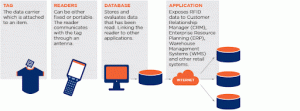What is RFID? RFID (radio frequency identification) is a form of wireless communication that incorporates the use of electromagnetic or electrostatic coupling in the radio frequency portion of the electromagnetic spectrum to uniquely identify the product tagged.
How Does It Work?
An RFID solution consists of
- RFID Reader
- RFID Tag
- Software
The reader is engaged in the generation and propagation of electromagnetic waves into the surrounding space. This signal is received by an RFID tag, which creates a reverse signal that is picked up by the antenna of the reader, then the received information is decrypted and processed by the electronic unit. An object equipped with an RFID tag is identified using a unique digital code that is stored in the memory of the electronic tag. For example, you can get individual user data or the identification number of a product in a matter of seconds.

Advantages of RFID Technology:-
- Rewrite, erase and add information – RFID solutions allows you to overwrite, erase or supplement data on a universal tag many times – Information once recorded on a barcode can never be changed
- There is no need for the label to get into the focus of the reader – To obtain data from the tag, the reader does not need its direct visibility – The full interaction of the chip with the reader occurs even through the packaging, wrapper or container – To read information, the microchip needs to briefly get into the interaction area, while it can move at high speed .To read information from a barcode or NFC chip, they always need to be within an acceptable line of sight radius
- Memory – An RFID tag, depending on the model, can store a very large amount of information in memory, compared to a 2D code
- High mechanical stability in harsh environments – Passive RF microchips have an unlimited service life – Models of body tags, created specifically for work in harsh working environments have a strong body and are difficult to damage – In contrast, the barcode is very easy to spoil, it loses performance even from exposure to moisture and pollution
- Long range – The RFID chip has a remote range, allowing you to read data at a very long distance .The barcode and the NSC chip do not have these parameters
- Multi-purpose application – RFID solution has a universal spectrum of action, in addition to the usual storage of information .A barcode is a non-rewritable device designed only to store certain information
- High level of security – The unique number assigned to the identifier acts as a guarantor against counterfeiting of the product .A micro-tag has the ability to encrypt the transmitted information .The owner can perform parsing functions such as writing and reading information from the chip .In one model, both open and closed information are easily saved.

Applications Across Industries:-
- Retail – With RFID, the movement of goods from the warehouse to the store and back is controlled – It becomes much easier to carry out inventories and prevent theft –
- Manufacture and sale of products – Each product can be marked with a special sign of mandatory marking
- Logistics – It helps to speed up loading and unloading, acceptance of goods, keep under control the movement of commodity residues – It also helps to reduce the mistakes of employees. RFID seals have become popular for high value cargo. Countries such as India and Taiwan have mandated these RFID seals for container movements.
- Production – Tracking the work of personnel and equipment, reduces the number of emergency situations, transmits raw material accounting data to the program
- Payment services – Contactless payment for goods and services
- In libraries, RFID solutions helps to quickly find and give the reader the right books, prevent theft, reduce queues and simplify inventory
- Travel in public transport: city and intercity buses, trolleybuses and trams, suburban trains and, of course, the metro – Sometimes they combine with school and student cards, combining two important functions in one subject
- Student cards are a convenient way to carry out access control in an educational institution – Usually these are nominal identifiers issued specifically for a specific institution
- Fuel cards for gas stations are a convenient way to pay at gas stations, which helps to increase customer loyalty – In the presence of such a card from a certain company, a person is unlikely to refuel at gas stations of other networks
- Key cards for hotel rooms – they make the stay of guests in the hotel not only safe, but also convenient – Cards with RFID tags help to study the behavior of guests and develop loyalty programs based on the information received
- A subscription to a fitness club is a great way to demonstrate the high level of the institution – The card allows you to track the number and duration of visits, implement bonus and discount programs
- Identifiers for access to services in sports complexes or resorts – the chip can be tied to an electronic wallet and when paying for services, you can debit money from it
- Discount and bonus cards in retail, gift certificates – they can be used to pay for purchases or accrue bonuses. The plastic itself is usually marked with advertising or reference information about the store. For the manufacture of such RFID cards, a chip is used with the ability to record additional information.
With the possible applications for RFID seemingly increasing, the list of potential use cases will continue to grow. RFID tags are popping up everywhere these days and as is the case with clever problem-solvers, companies are using RFID in ways its original innovators couldn’t have possibly foreseen.
Simple, scalable, and inexpensive, RFID is an ideal building block technology and adopters are leveraging the technology to drive value in their core business.

